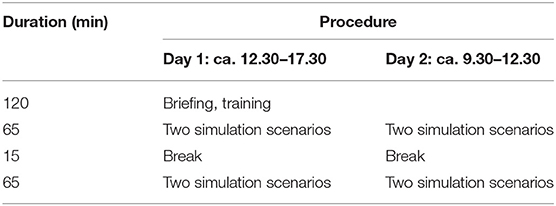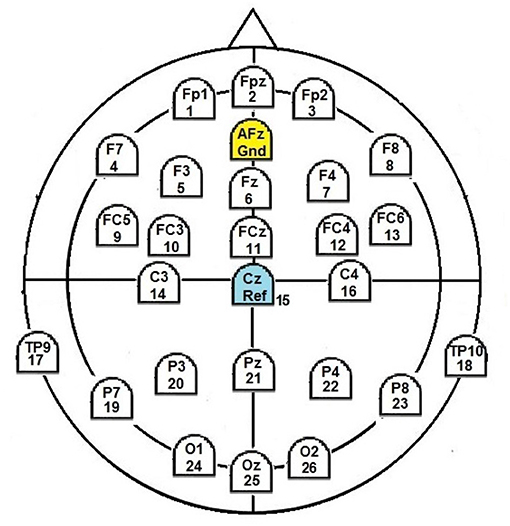- 1Mental Health and Cognitive Capacity, Work and Health, Federal Institute for Occupational Safety and Health, Berlin, Germany
- 2Institute of Flight Guidance, German Aerospace Center, Braunschweig, Germany
- 3Signal Processing and Pattern Recognition, Department of Computer Science, Humboldt-Universität zu Berlin, Berlin, Germany
In our digitized society, advanced information and communication technology and highly interactive work environments impose high demands on cognitive capacity. Optimal workload conditions are important for assuring employee's health and safety of other persons. This is particularly relevant in safety-critical occupations, such as air traffic control. For measuring mental workload using the EEG, we have developed the method of Dual Frequency Head Maps (DFHM). The method was tested and validated already under laboratory conditions. However, validation of the method regarding reliability and reproducibility of results under realistic settings and real world scenarios was still required. In our study, we examined 21 air traffic controllers during arrival management tasks. Mental workload variations were achieved by simulation scenarios with different number of aircraft and the occurrence of a priority-flight request as an exceptional event. The workload was assessed using the EEG-based DFHM-workload index and instantaneous self-assessment questionnaire. The DFHM-workload index gave stable results with highly significant correlations between scenarios with similar traffic-load conditions (r between 0.671 and 0.809, p ≤ 0.001). For subjects reporting that they experienced workload variation between the different scenarios, the DFHM-workload index yielded significant differences between traffic-load levels and priority-flight request conditions. For subjects who did not report to experience workload variations between the scenarios, the DFHM-workload index did not yield any significant differences for any of the factors. We currently conclude that the DFHM-workload index reveals potential for applications outside the laboratory and yields stable results without retraining of the classifiers neither regarding new subjects nor new tasks.
1. Introduction
In our digitized society, advanced information and communication technology and highly interactive work environments impose high demands on cognitive capacity and on the ability to cope with increased task load (Kompier and Kristensen, 2001; Niosh, 2002; Landsbergis et al., 2003; Lohmann-Haislah, 2012). According to several authors mental workload can be conceived as the amount of cognitive demands required in order to solve a task related to the cognitive resources available (Kahneman, 1973; Eggemeier et al., 1991; Xie and Salvendy, 2000; Wickens, 2002).
Optimal workload conditions are important for the health of the single individual and in order to assure the safety of other persons. Latter is particularly relevant in safety-critical occupations with high cognitive demands and responsibility, such as air traffic control. A valid and reliable method for measuring mental workload would offer a way for achieving such conditions in human-machine systems by capturing the instantaneous workload continuously over time (Byrne and Parasuraman, 1996; Scerbo et al., 2001; Arico et al., 2017). It is important that the registration method does not interact with the task or alter subject's mental state by imposing additional demands as it is the case during subjective assessment of workload by means of questionnaires. Furthermore, the workload should not only be detectable in retrospect or after the occurrence of errors as it is the case when performance measures are used for workload detection. Thus, questionnaires and performance evaluation are only of limited relevance for real-time analysis of workload conditions in the range of seconds.
Over the past 50 years, various physiological parameters (e.g., heart rate and derived parameters, electrodermal activity, body temperature, etc.) have been evaluated for their validity regarding continuous mental workload registration. Since the discovery of the electroencephalogram (EEG) by Berger (1929), relations between bioelectric brain activity and cognitive states have been studied. Improvements of the amplifier technology and computerized evaluation of biosignals made systematic investigations possible. In last century's 90s, the state-of-the art regarding EEG's evaluation and validity was summarized in reviews that served as a starting point for the use of the EEG in applied research, e.g., in human-factors. In a review article, Borghini et al. (2014) provided a detailed overview of the measurement of neurophysiological signals for the determination of mental workload and confirmed essentially the known relations. The authors further concluded that no convincing algorithms were available for a reliable online workload detection.
The spectral power of oscillations in different frequency bands were used as parameters for describing the spontaneous brain activity. For the alpha-frequency (8–12 Hz) and theta-frequency (4–8 Hz) bands, spectral-power comparisons in all relevant investigations described systematic relations to cognitive and memory performance (Sterman and Mann, 1995; Pfurtscheller, 1997; Gevins et al., 1998; Klimesch, 1999; Gevins and Smith, 2000). These EEG bands were also linked to different levels of workload by means of analysis of variance (e.g., Mecklinger et al., 1992; McEvoy et al., 2001; Lei and Roetting, 2011; Brouwer et al., 2012; Capilla et al., 2012; Aricò et al., 2018) and demonstrated a decrease of the alpha-frequency band power and an increase of the theta-frequency band power with increasing mental workload.
In recent years, however, classifiers were increasingly used for the separation of workload levels. The feature vectors—derived from the EEG—revealed varying complexity and extent, and frequency bands were taken differently into account. The used EEG parameters were, for example, the amplitude of the EEG signal, spectral power of different frequency bands, and different EEG channels (Wilson and Russell, 2003b; Lin et al., 2006; Kohlmorgen et al., 2007; Baldwin and Penaranda, 2012; Penaranda and Baldwin, 2012; Ke et al., 2014). The focus was on frontal, parietal and occipital EEG channels according to previous findings. Independent component analysis (ICA) was used to determine specific reactions of spatio-temporal different sources (Gardony et al., 2017) and allowed the successful detection and elimination of artifacts (Mognon et al., 2011; Radüntz et al., 2017; Puma et al., 2018).
Initially, studies that dealt with the determination of workload were conducted in the laboratory using different task batteries (Gevins et al., 1998; Gevins and Smith, 2000; McEvoy et al., 2001; Berka et al., 2007; Grimes et al., 2008; Baldwin and Penaranda, 2012; Brouwer et al., 2012, 2014; Christensen and Estepp, 2013; Weiland et al., 2013; Gerjets et al., 2014; Hogervorst et al., 2014; Ke et al., 2014; Hou et al., 2016; Gardony et al., 2017; Rosen and Reiner, 2017; Puma et al., 2018). Meanwhile, investigations of cognitive workload with more realistic tasks became more popular (Kohlmorgen et al., 2007; Lei and Roetting, 2011; Aricò et al., 2018; Dehais et al., 2018). Air traffic controllers (ATCOs) pose a special challenge due to the complex task-load situations with changing activities and strategies for air traffic management (ATM). The requirements can change very fast, a clear and direct objective graduation of task-load proves to be difficult, and the transitions are often unpredictable and fast. Experiments with ATM simulations and a task-load grading proved to be advantageous although the majority of simulated ATM examinations were limited to two task-load levels (easy and difficult). Relevant studies on workload determination methods for simulated or real air traffic control were conducted by Brookings et al. (1996), Wilson and Russell (2003b, 2007), Shou et al. (2012), Abbass et al. (2014b,c), Borghini et al. (2014, 2017), Aricò et al. (2015, 2016); Aricò et al. (2018), Di Flumeri et al. (2015), Dasari et al. (2017), and Dehais et al. (2018).
Wilson and Russell (2003a) investigated the classification of the mental state of seven air traffic controllers in simulated air traffic monitoring. In seven different task-load conditions a 19-channel EEG, heart rate, blink rate, and respiratory rate were recorded. The spectral power of five frequency bands was calculated for each EEG channel from 1-s windows and used per subject as input for the artificial neuronal networks (ANN) and stepwise linear discriminant analysis (SWLDA). Discrimination only between two conditions yielded the best result with an accuracy of 97.5% (ANN) and 91% (SWLDA). Thereby only 22 relevant features were included in the evaluation. The authors drew attention to the following open questions of day-to-day variability of psychophysiological measures and long training duration for ANN. They stated that a one-size-fits-all solution would be beneficial.
Abbass et al. (2014c) dealt with questions about visual and auditory information processing in relation to mental workload of air traffic controllers. In addition, the authors examined the question of whether a narrow-band frequency resolution of the EEG was better suited for the assessment of workload. They found that there were no quantitative advantages over the usual frequency bands. Further, they suggested to focus on the separation of high and low workload and neglect the middle range (Abbass et al., 2014a).
The question of reliability of EEG-based workload determination in ATM tasks was examined in Arico et al. (2015). According to the authors the reason for the decreasing classification accuracy over days, as reported by Christensen and Estepp (2013), could be overfitting, i.e., a too high specificity of the training data. It was hypothesized that a simple classifier based on fewer spectral properties guaranteed a high selectivity over days. Twelve ATCO interns completed the simulated ATM task on 2 consecutive days and after 9 days. The EEG was registered by 13-channels and 2 s windows were used to compute relevant EEG spectral features. For each subject, cross-validation of the classifier between the days was calculated using 5, 50, and 100% of relevant EEG features. The results showed that the use of only 5% of the relevant features contributed to an over-day stable workload measurement.
Basically, changes in the alpha-frequency and theta-frequency band powers related to mental workload have been confirmed many times and proved to be meaningful in accordance with the findings of the last 50 years. The majority of workload studies dealt with the analysis of the EEG during cognitive tasks related to working memory and executive control. While some authors investigated whether a brain-state monitoring was possible on the basis of universal and general activation signs in the EEG (Bashivan et al., 2014, 2015; Ke et al., 2014), others tested the possibilities and limitations of over task requirements (cross-task training) and inter-individually (cross-subject training) transferable classifiers. Discrimination accuracy of the classifiers between high and low workload was often not sufficient in cross-task training and remained below the significance threshold. Cross-subject training of the classifier was also less favorable than intra-subject classification. In the driving simulator study by Kohlmorgen et al. (2007), the authors concluded that a highly adaptive approach was needed to account for the neurophysiological variations. According to the authors, a universally applicable “workload detector” with fixed parameters did not seem to be realistic at the moment. The selection of appropriate data for classifier's training needs more elucidation. This is especially important as frequent allegations were made concerning the time interval between training and test of the classifier that proved to be particular relevant for the classification accuracy (Penaranda and Baldwin, 2012). In order to avoid overfitting and increase the stability of the classifier performance over time a smaller number of features could be beneficial (Arico et al., 2015).
It has to be stated that different cognitive strategies in task solving, both intra- and inter-individually, can influence the classification results. In this context, Puma et al. (2018) suggested to cluster the subjects according to their performance, age (McEvoy et al., 2001), and individual experiences. These should be considered if workload registration methods are to be validated.
Based on the possibility that machine learning algorithms provide the ability of workload registration in the range of seconds, the question arises whether they provide reliable and reproducible results over time, in particular without the need for re-training of the classifier regarding subjects and tasks. For their practical application at the workplace, it is also important that their applicability is examined not only in the laboratory but also under more realistic conditions. This becomes particularly important when considering the technological advancements regarding mobile EEG technology that have simplified signal registration outside of shielded rooms (Mihajlovic et al., 2015; Aricò et al., 2018; Radüntz, 2018; Baek et al., 2019; Radüntz and Meffert, 2019).
In our prior work we developed a mental-workload classifier that does not need retraining, neither for new subjects nor for new tasks (Radüntz, 2017). In a laboratory study conducted with 54 subjects and during execution of well-established cognitive tasks, we developed the so-called Dual Frequency Head Maps (DFHM). These head maps consist of personalized spectral features and their spatial occurrence (i.e., frontal theta-band and parietal alpha-band powers). Support vector machines are used for classification in three classes: low, moderate, or high workload. Under laboratory conditions, we successfully proved the DFHM method as universally applicable with fixed parameters for mental-workload indexing. For proofing the reliability and reproducibility of our DFHM method's results under realistic conditions, we conducted a study in cooperation with the German Aerospace Center and focused on air traffic controllers. The following four research hypotheses were formulated for the DFHM-validation study:
1. The DFHM method yields stable results under similar task-load conditions independently of the time of measurement.
2. The DFHM method is able to assess workload differences that arise from different traffic-volumes conditions.
3. The DFHM method is able to assess workload differences that arise from an exceptional-event condition.
4. The objectively measured workload assessed by the DFHM method is related to controller's subjectively experienced workload.
2. Materials and Methods
2.1. Research Design
Our study took place at the Air Traffic Management and Operations Simulator (ATMOS) of the German Aerospace Center (DLR) in Braunschweig. Thereby, air traffic controllers focused on simulated arrival management procedures presented on the monitor and interacted along the experimental task with pseudo pilots who simulated the cockpit crews. The implemented simulation scenarios differed regarding two factors that were responsible for mental workload variations of air traffic controllers as suggested by Averty et al. (2004). The first one was the traffic load. In our case, we had four levels corresponding to four different numbers of aircraft per hour (ac/h). The second factor was an exceptional event that could occur or not. This event was a pilot's request for a flight prioritization because of a sick passenger on board. The priority-flight request could occur around the 11th min of the 20–25 min lasting scenario. Both factors led to the eight scenarios presented in Table 1.
2.2. Procedure and Subjects
We asked subjects to participate in a 2-days experiment where they had to complete the above-mentioned eight traffic scenarios in randomized order. The experimental procedure is outlined in Table 2. The investigation consisted of an introductory session and the main experiment. During the introductory session participants completed demographic questionnaires, were briefed regarding the research goals and experimental procedure of the following 2 days, and had a training session at the simulator in order to get familiarized with the environment. During the main experiment the subjects completed four of the simulation scenarios while the remaining four were conducted on the second day.
In our study, we examined 21 subjects in the age between 22 and 64 years (2 females, 19 males, mean age 38 ± 11). Subjects were from different airports, had different work experience, revealed different work positions (i.e., 13 approach controllers, three tower controllers, and five employees of the DLR), and had experienced different work demands. However, all of them had adequate expertise to handle the arrival management simulation.
All of the investigations acquired were approved by the local review board of our institution and complied with the tenets of the Declaration of Helsinki. All procedures were carried out with the adequate understanding and written consent of the subjects.
2.3. Subjective Ratings
In order to register the subjectively experienced workload, we used the instantaneous self-assessment (ISA) questionnaire. This was developed for the assessment of air traffic controller's mental workload (Brennan, 1992; Jordan, 1992; Kirwan et al., 1997) and consisted of a one-dimensional scale. Thus, it was quickly and easily conducted in an interval of 5 min during all eight scenarios. According to their feeling during the previous 5 min, subjects indicated their workload using a touch screen. Thereby, they selected one of the following five values: (1) under-utilized, (2) relaxed, (3) comfortable, (4) high, and (5) excessive.
Analysis of the ISA questionnaire results was particularly relevant for our fourth hypothesis related to controller's subjectively experienced workload. Based on these we developed a so-called workload-sensitivity index that considered the individual range of experienced workload during different task-load conditions.
Subject's normalized workload-sensitivity index sa was based on a linear model for the dependence of subjectively experienced workload as assessed by the ISA questionnaire and traffic load. In Fürstenau et al. (2020), we showed that the linear model was able to predict the ISA value with a high confidence for means across the subjects and provided reasonable linear correlation coefficients for the individuals. Independence from the arbitrary ISA values was achieved via normalization by scales' means, i.e., (traffic loadmax + traffic loadmin) / 2 for the traffic volume and (ISAmax + ISAmin) / 2 for the subjective workload, resulting in anticorrelated (normalized) sensitivity and intercept sb = 1 − sa. ISA-scale means were conducted individually for each subject based on the ISA-extreme values from their regression lines.
Our workload-sensitivity index ranged between 0.32 and 1.23, and was used for subject clustering. The aim of this clustering was an improved investigation of the cognitive phenomena only of those subjects that actually experienced different workload levels. Subjects with an index below the median of 0.8 were clustered as not sensitive, while subjects with an index equal or above the median as workload sensitive. Generally speaking, workload-sensitive subjects experienced more workload variation during the different simulation scenarios whereas the not-sensitive subjects rated the subjectively experienced workload with less variation.
2.4. EEG and DFHM-Workload Index
Biosignal processing and all calculations were done with MATLAB.
For EEG registration we used g.tec's g.LADYbird/g.Nautilus system with 25 active electrodes placed at positions according to the 10–20-system (Figure 1). Registration was carried out with a sample rate of 500 Hz and with reference to electrode Cz. For signal recording we used g.tec's Matlab interface.
After recording, the EEG was filtered with a bandpass filter (order 100) between 0.5 and 40 Hz for enhancing the separation accuracy of the following analysis for artifact rejection (Fernandez, 2009; Omatu et al., 2010; Pignat et al., 2013; Winkler et al., 2015). Independent component analysis [ICA, Infomax algorithm (Makeig et al., 1996)] for artifact rejection was applied to the signal. Components to reject were manually selected (i.e., on average 16 out of 25 per subject). In order to increase topographical localization, we applied a simple Hjorth-style surface laplacian filter using eight neighbors (Hjorth, 1975). This spatial high-pass filter was aimed to attenuate large-scale scalp signals and amplify localized signals.
The artifact-free EEG was transformed to average reference and cut into segments of 1 s length, overlapping by 0.5 s. By means of Fast Fourier Transformation (FFT) we computed the workload relevant frequency bands (theta: 4–8 Hz, alpha: 8–12 Hz) over the segments. Table 3 shows the general tendencies of both frequency bands exemplary for two electrodes. Involvement of all electrodes, the combination of both frequency bands, and the personalization of the band-power values aim at enhancing workload classification and constitute the DFHM that were generated as outlined in Radüntz (2017). In brief, we applied a theta-bandpass filter to the signals of the frontal electrodes and an alpha-bandpass filter to the signals of the parietal electrodes and calculated for each participant, each electrode, and each segment the z-scores of theta and alpha band power. The individual mean and standard deviation for z-score calculation were obtained from subject's segments of the first minute of each scenario. This compilation of the z-scores of the theta band power from the frontal electrodes and alpha band power from the parietal electrodes constituted the DFHM for each EEG segment. Next, each DFHM from the simulation scenarios' segments was classified using the already trained SVM classifier from the laboratory study. Retraining of the DFHM classifier was not necessary neither for the new subjects nor for the new tasks. The general characteristic of these maps and thus, the classifier is universally applicable because of the z-score calculation. For more information about the DFHM and classifier development, we refer the interested reader to our method article (Radüntz, 2017).
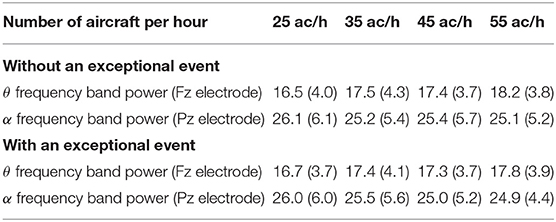
Table 3. Mean and standard deviation (in parenthesis) of the α and θ frequency band powers exemplary for two electrodes averaged over the subjects for each simulation scenario.
We obtained every 0.5 s a value of 1 (low workload), 2 (moderate workload), or 3 (high workload). We applied a moving-average time window of 30 s as suggested by Abbass et al. (2014a) and adjusted the result in order to gain a DFHM-workload index between 0 and 100 (Equation 1; with t: workload index at time t, DFHM (i): classification value of DFHM from segment i).
In particular, for each moving-average time window of 30 s we firstly calculated the sum of the 60 values resulting from the DFHM every 0.5 s. In order to have a baseline of 0, we subtracted the minimum-possible sum of 60 for the case where all DFHM of the window indicated a low workload of 1. Thus, the maximum-possible sum for the case where all DFHM of the window indicated a high workload was 120. Dividing by the latter and multiplying by 100 provided the percentage amount of high-workload segments in a time-window of 30 s. This constituted the DFHM-workload index between 0 and 100 computed every 0.5 s.
2.5. Statistical Analysis
For evaluating our first hypothesis and proof the reliability of the DFHM index, we calculated the DFHM-index average over the first 5 min of each simulation and correlated the means of scenarios with same traffic load.
For investigating the ability of the DFHM method to assess mental workload arising from the traffic volume (hypothesis 2) and the occurrence of an exceptional event (hypothesis 3), we looked at the time slots immediately after the time of a possible priority-flight request. This was triggered in the data using g.tec's g.TRIGbox. For scenarios with a priority-flight request we considered a DFHM-index segment of 2.5 min starting from the request time point. For scenarios without a priority-flight request we used the same time slots. We carried out an analysis of variance (ANOVA) with the slots' mean DFHM index as dependent variable. We utilized a repeated-measures design with two within-subject factors (two levels for the priority-flight request factor and four levels for the traffic-volume factor). General differences between the levels were examined and tested with a post-hoc test (Bonferroni corrected).
Finally, we addressed the issue of DFHM-index workload registration in relation to subjects' subjectively experienced workload (hypothesis 4). We clustered our subjects in two groups using the median of our workload-sensitivity index that was calculated from the ISA ratings. This yielded nine subjects that subjectively did not experience workload variations between the scenarios and 12 workload-sensitive subjects. We carried out a mixed ANOVA with cluster affiliation as between-subject factor followed by a two-factorial ANOVA for each cluster separately for determining the simple main effects of our factors. The dependent variable, within-subject factors, and levels were identical with those mentioned above. Similarly, we utilized a repeated-measures design and examined the differences with post-hoc tests (Bonferroni).
Statistical calculations were conducted using SPSS and the significance threshold was set at 5%.
3. Results
3.1. DFHM Index Under Similar Conditions
Our first hypothesis was concerned with the ability of the DFHM method to yield stable results under similar task-load conditions. Scenarios with and without priority-flight request were identical regarding their traffic volumes until the 10th min where the request could occur. Thus, we decided to use only the first 5 min of each simulation for assuring similar task load conditions between both values to be correlated. By taking a larger slot, the scenarios would increasingly differ the more time passed away as consequence of the interactive communication of the ATC with the pseudo pilots.
Correlation analyses between the mean DFHM index of the first 5 min of simulation scenarios with same traffic load showed significant positive correlations. These were particularly high for the traffic-load conditions of 35 and 45 ac/h and less pronounced for the lowest traffic load of 25 ac/h. Person's correlation coefficients are presented in Table 4.

Table 4. Correlation analysis of DFHM-index means over the time slot 0–5 min during scenarios with equal traffic-load volume (N = 21, ***p ≤ 0.001).
3.2. DFHM Index Related to Traffic Load and Priority-Flight Request
In order to evaluate the ability of the DFHM method to assess workload differences arising from different traffic-volume and exceptional-event conditions, we considered the results of the ANOVA. They were calculated with the two within-subject factors traffic-load and priority-flight request. The results are summarized in Table 5.
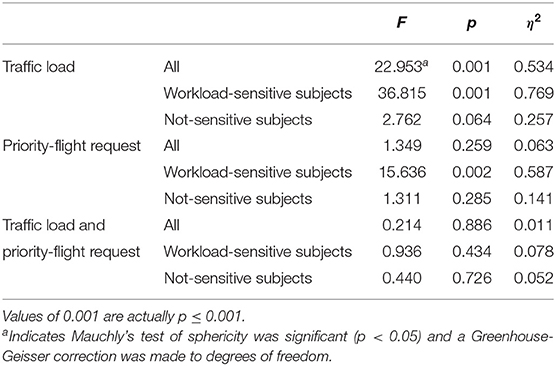
Table 5. Analysis of DFHM index across simulation conditions over all subjects and subjects' clusters, respectively.
Related to our second hypothesis the traffic load had a significant main effect on the workload as assessed by the DFHM index. Bonferroni corrected post-hoc tests showed significant differences between all levels except between the 35 and 45 ac/h conditions. The DFHM-workload index increased with increased traffic. Figure 2 shows the results. The impact of the priority-flight request as related to our third hypothesis did not became significant. No interaction effect could be obtained between traffic load and priority-flight request.
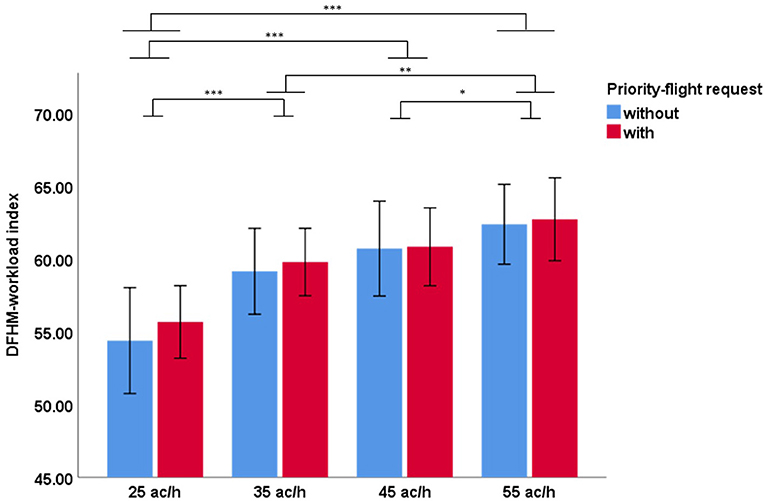
Figure 2. Mean DFHM index over 21 participants measured during the 2.5 min slots after a possible priority-flight request across simulation conditions with (red) and without (blue) priority-flight request at different traffic loads (Bonferroni corrected post-hoc tests: ***p ≤ 0.001; **0.001 < p ≤ 0.01; *0.01 < p ≤ 0.05; error bars indicate 95% confidence interval).
For assuring that air traffic controllers indeed prioritized the aircraft, we evaluated the route distances of the same aircraft with and without priority-flight request. In both cases the route distance taken was the length of trajectory between the initial contact time point and landing. A shorter route distance for the requesting aircraft indicated that air traffic controllers complied with the priority-request condition (Figure 3). Wilcoxon signed-ranks tests (with Bonferroni correction) indicated that the route distance was significantly shorter during scenarios with priority-flight request compared to scenarios with same traffic volume but without priority-flight request (Table 6).
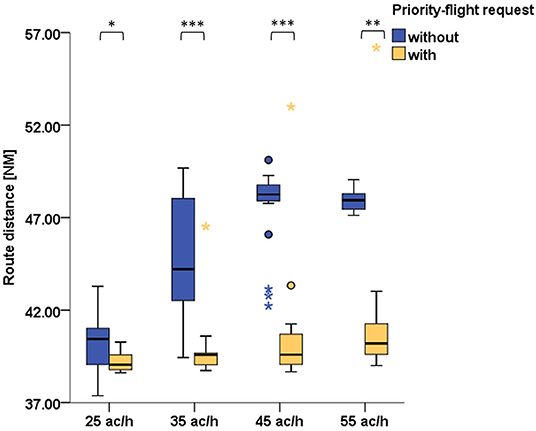
Figure 3. Comparison of prioritized aircraft's route distance during scenarios with priority-flight request (orange) and during scenarios with same traffic volume but without prioritization (blue) for all 21 subjects (Wilcoxon signed-ranks tests with Bonferroni correction: ***p ≤ 0.001; **0.001 < p ≤ 0.01; *0.01 < p ≤ 0.05).
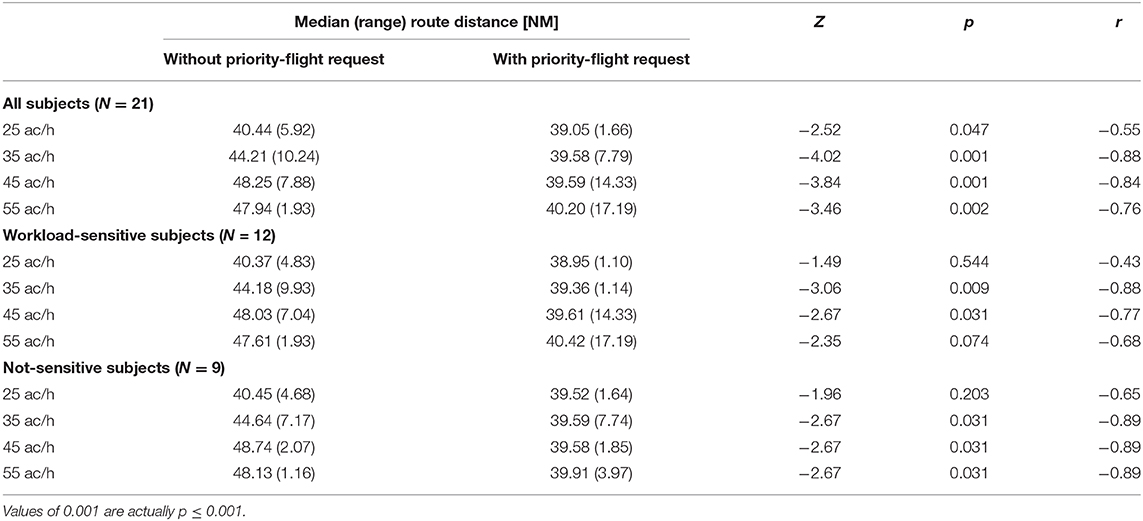
Table 6. Wilcoxon signed-ranks tests (with Bonferroni correction) for comparison of prioritized aircraft's route distance during scenarios with priority-flight request and aircraft's route distance during scenarios with same traffic volume but without priority-flight request.
3.3. DFHM Index Related to Subjectively Experienced Workload Variations
For our last hypothesis, results from the mixed ANOVA showed statistically significant interaction effects between cluster affiliation and traffic load [F(3, 57) = 7.215, p < 0.001, η2 = 0.275] as well as between cluster affiliation and priority-flight request [F(1, 19) = 9.517, p = 0.006, η2 = 0.334]. No significant interaction effect could be obtained between all three factors cluster affiliation, traffic load, and priority-flight request [F(3, 57) = 1.195, p = 0.319, η2 = 0.059].
In the following, we analyzed the DFHM index for the workload-sensitive cluster and the not-sensitive cluster separately. For the workload-sensitive cluster the ANOVA yielded a significant main effect for the traffic load and priority-flight request. Bonferroni corrected post-hoc tests showed significant differences between all traffic-load levels except between the highest traffic load volumes with 45 and 55 ac/h. The DFHM-workload index increased with increased traffic load and was higher during scenarios with priority-flight request. No interaction effect could be obtained between both factors.
For the not-sensitive cluster no significant differences could be obtained for none of the factors. The results are summarized in Table 5 and shown in Figure 4.
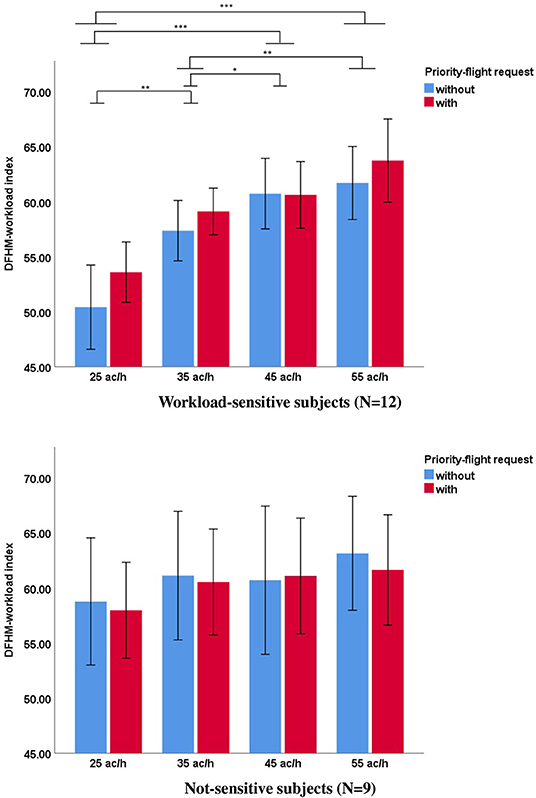
Figure 4. Mean DFHM index during scenarios with (red) and without (blue) priority-flight request at different traffic loads for workload-sensitive (top row) and not-sensitive (bottom row) subjects (Bonferroni corrected post-hoc tests: ***p ≤ 0.001; **0.001 < p ≤ 0.01; *0.01 < p ≤ 0.05; error bars indicate 95% confidence interval).
3.4. Performance Related to Subjectively Experienced Workload Variations
In addition to the DFHM index we evaluated the performance of the air traffic controllers for the workload-sensitive and not-sensitive clusters. As measure of performance we employed the route distances and loss of separation. Evaluation of route distance between aircraft with priority-flight request and without was conducted separately for each cluster. The results are presented in Table 6 and Figure 5 and revealed similar tendencies for both clusters, i.e., the route distance of the requesting aircraft was significantly shorter during 35 and 45 ac/h traffic load. During the 55 ac/h condition this held true only for the not-sensitive cluster. No significant difference could be found for none of the clusters during the 25 ac/h condition.
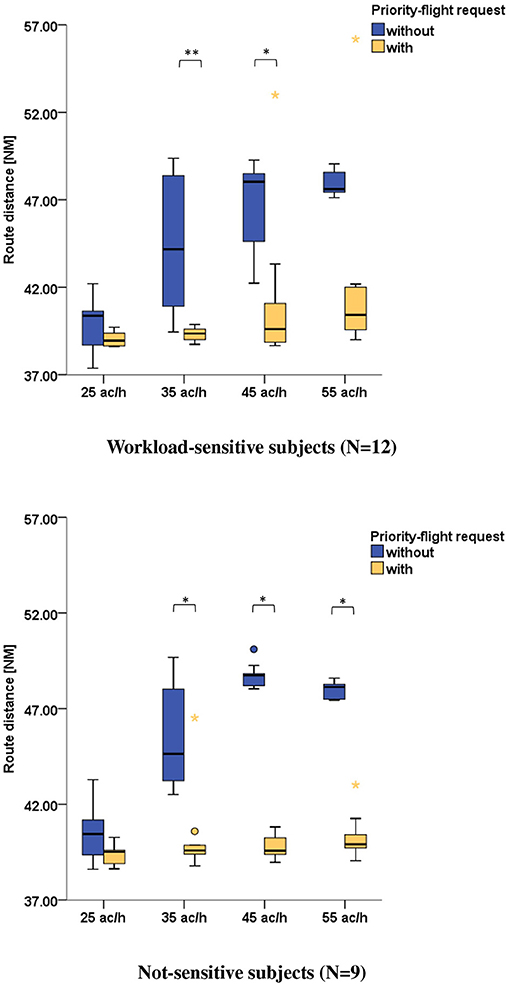
Figure 5. Comparison of prioritized aircraft's route distance during scenarios with priority-flight request (orange) and during scenarios with same traffic volume but without prioritization (blue) for workload-sensitive (top row) and not-sensitive (bottom row) subjects (Wilcoxon signed-ranks tests with Bonferroni correction: **0.001 < p ≤ 0.01; *0.01 < p ≤ 0.05).
Evaluation of loss of separation between aircraft was conducted according to the minimum separation standards specified by the authorities and based on the standards of the International Civil Aviation Organization (2011). The separation minima were breached when lateral distance between two aircraft was smaller than the required vake vortex separation, i.e., 3 NM (nautical miles) for two medium type aircraft and 5 NM for a medium aircraft following a heavy aircraft, and simultaneously vertical distance between these aircraft was smaller than 1,000 ft. In general, the number of loss of separation was low (i.e., around zero) and thus not appropriate for statistical evaluation. For the sake of completeness, Figure 6 illustrates the results for each cluster separately.
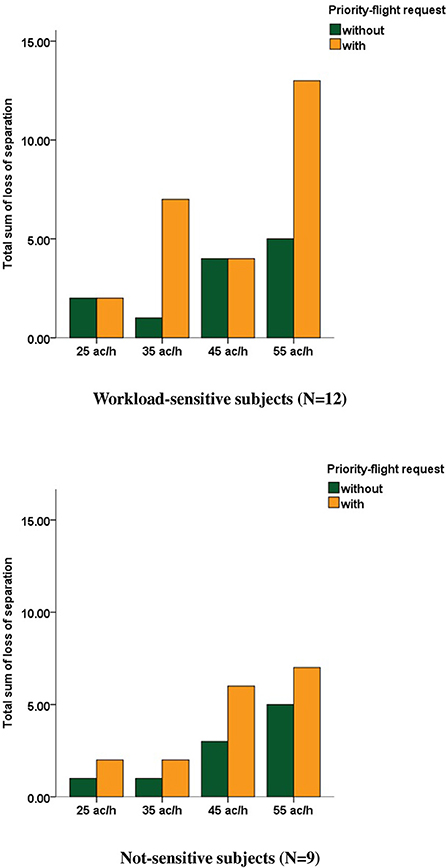
Figure 6. Total sum of loss of separation computed over all workload-sensitive (top row) and not-sensitive (bottom row) subjects during scenarios with (orange) and without (green) priority-flight request at different traffic loads.
4. Discussion
In our study, we aimed in validating our method for mental workload registration by means of DFHM. The method was already proofed in a laboratory setting but further evaluation was needed. Our current validation study was conducted under realistic conditions, with real tasks, and new subjects, i.e., in an air traffic control simulator, with arrival-management tasks, and air traffic controllers. Our sample set consisted of 21 subjects that completed eight simulation scenarios in randomized order. The simulation scenarios differed regarding their traffic load that consisted of four levels and a priority-flight request that could occur around the 11th min of simulation or not. We registered the EEG during the simulations and computed the DFHM-workload index for each subject and scenario. We did not retrain the classifiers neither for the new tasks nor for the new subjects. The gained results were promising.
The DFHM index gave stable results with highly significant correlations between scenarios with similar traffic-load conditions as stated by hypothesis 1. We observed that these correlations were particularly pronounced during the medium and high traffic volumes and less strong for the low-traffic volume. During the latter, requirements were very low and allowed air traffic controllers to have task-unrelated thoughts in order to cope with boredom (Cummings et al., 2015). Boredom proneness, coping strategy as well as the kind of task-unrelated thoughts could have mitigated the correlation between the two 25 ac/h scenarios. One could argue that there might be also other factors that might influence results stability across scenarios, e.g., effects of learning and fatigue in the course of time, the interaction with the pseudo pilots, or the initial excitement during the presentation of the first scenario. However, our sample was very specialized. Air traffic controllers are highly trained and it seemed unlikely that they gained knowledge in the course of the experiment. The initial training phase prior to our experiment was aimed to familiarize the subjects with the environmental conditions and eliminate issues related to these. For minimizing fatigue effects, we followed the regulations of working-time organization for air traffic controllers that prescribe a break after 120 min of work. Each scenario had a maximal duration of 25 min, a break took place after two scenarios (i.e., after 50 min), and the daily session consisted of four simulation scenarios. Effective daily-work time was 100 min the most. Hence, fatigue effects should be minimal. Presentation order of the scenarios was randomized and should compensate the initial excitement across subjects. Finally, air traffic controllers should be used to the interaction with different pilots from their daily work experience. Hence, we concluded that workload differences should result from the experimental conditions and the DFHM-workload index should be comparable during the first minutes of simulations with equal traffic load. Nevertheless, we have to draw attention on the increased requirement on our DFHM-workload index because of our 2-days experiment with randomized presentation order of the scenarios. Keeping this in mind, results from the correlation analysis appear encouraging.
While the first hypothesis was concerned with test-retest reliability, the second and third hypotheses addressed the issue of validity of the DFHM method as workload indexing technique. The DFHM index was able to assess significant differences between the different levels of air traffic volume as stated by hypothesis 2. Problematic were the neighboring levels with 35 and 45 ac/h that could not be significantly discriminated by the DFHM-workload index when considered over all subjects. The same held true regarding the priority-flight request although evaluation of the route distance of the requesting aircraft indicated that air traffic controllers complied with the task. At this stage hypothesis 3 had to be rejected when considered over all subjects.
More insight regarding intra-individual differences linked to the DFHM-workload index was gained from subject clustering by means of the subjectively experienced workload differences during the scenarios. Thus, our fourth hypothesis dealt not only with issues of validity but also of consistency between subjective and objective measuring methods. We were able to obtain highly significant interaction effects between subjective workload-cluster affiliation and traffic load as well as priority-flight request. For subjects reporting that they experienced workload variation between the different scenarios, the DFHM-workload index yielded significant differences between traffic-load levels and priority-flight request conditions. Interestingly, for these subjects the DFHM index was able to differentiate between the neighboring levels with 35 and 45 ac/h but not between the 45 and 55 ac/h conditions. Descriptive evaluation of Figure 4 indicates that for the workload-sensitive subjects there was a ceiling effect regarding traffic volume. This occurred for traffic-volumes >45 ac/h and seemed reasonable when taken into account that a traffic volume of 55 ac/h was a condition that is highly improbable in reality for single-runway operations. Latter was constructed for the simulation in order to create an extreme situation that would definitely challenge the operators and increase their workload. Nevertheless, air traffic controllers are trained to adjust their work strategies in order to assure safety. This strategy change could be a reason for the ceiling effect during the very high traffic-load condition. However, the occurrence of a priority-flight request during the very high traffic-load condition led to a further increase of the DFHM-workload index. Unfortunately, our small sample size and the even smaller amount of subjects in the clusters did not allow for elaborated statistics regarding interaction effects.
In contrast to the significant differences obtained for the workload-sensitive cluster, the DFHM-workload index behaved differently for the not-sensitive cluster and did not yield any significant differences for any of the factors. In our opinion, this fit well to our fourth hypothesis and indicated that the objectively measured workload assessed by the DFHM method corresponded to controller's subjectively experienced workload. To sum up, hypothesis 2 and 3 proofed true only for subjects that experienced workload differences also subjectively during the scenarios. The workload insensitivity of subjects might appear odd when considering the high variability of our experimental design. An explanation might be traced back to the different cognitive strategies in task solving, both intra- and inter-individually, that might influence the experienced workload. Each controller had a different way to handle the traffic. This was possibly related to the different individual experience level from daily-work life as linked to the size of the airport he was working, the different ages, but also personality traits. Unfortunately, we were not able to identify personal characteristics for each cluster that might be responsible for the different perceptions of workload. More research is needed in order to understand which individual factors contribute to these interpersonal differences.
Analyses of performance data emphasized these findings. Results revealed a tendency to more loss of separation and lower prioritization during the extreme traffic load condition for workload-sensitive subjects that was less pronounced for the not-sensitive subjects. These might be an additional indicator that subjects from the workload-sensitive cluster experienced more workload compared to the others as evident by the DFHM-workload index. As a side note, readers might wonder that route-distance difference was low between the 25 ac/h scenarios with and without priority-flight request. This was reasonable because of the low-traffic volume that allowed air traffic controllers to instruct pilots to fly direct routes to the final approach even without a priority-flight request by the pilot. Conversely, a weaker significance level for the route-distance difference between both 55 ac/h scenarios could be linked to a smaller ability to prioritize the aircraft due to increased demands resulting from the high-traffic load.
A limitation of our study was the realization of the exceptional event as recurring priority-flight request. The surprising effect of the unexpected event might have diminished after the first occurrence of the request. Thereafter, air traffic controllers might have adjusted their strategy and behavior in order to be prepared to appropriately react to a recurring event. Studies that aim to understand the effect of an unexpected event on workload, should pay more attention on this issue. Finally, a larger sample size would be beneficial.
5. Conclusions
With the development and availability of low-cost and easy-to-use EEG sensors, amplifiers, and signal-processing algorithms over the last 20 years (Lopez-Gordo et al., 2014; Radüntz, 2018; Flumeri et al., 2019; Radüntz and Meffert, 2019), certain frequency bands of the EEG have proven to be particularly informative and were therefore being used more and more frequently for mental-workload detection. The numerous studies published after the year 2000 were fairly different, depending on the specific question, purpose, and expertise of the authors (Lin et al., 2006; Berka et al., 2007; Kohlmorgen et al., 2007; Borghini et al., 2014; Ke et al., 2014; Bashivan et al., 2015; Aricò et al., 2016). Initially, the spectral power in the alpha and theta frequency bands were identified as particular relevant, analyzed, and tested variance-analytically related to mental workload. In the last few years classifiers that relied on large property vectors of EEG activity were increasingly developed. Thereby, the derived parameters let barely identify the concrete psycho-physiological meaning of the EEG activity. We aimed to avoid this issue by making use of well-established parameters that should be valid for different subjects and tasks.
In our article, we particularly addressed questions of functionality outside the laboratory, stability of results, and the generalization properties of the DFHM-workload index, inter-individually and cross-task. In conclusion, it can be stated that a reliable determination of mental workload in a realistic setting and with real-world scenarios was possible. Continuous determination under real conditions, however, requires further systematic investigations. Although the temporal resolution of the EEG permits a workload determination in the range of seconds, the states to be detected originate from long-running procedures and therefore require further research about an informative time frame for averaging classifier's output. Future promising applications of the DFHM-workload index include research about effects of human-computer interaction, human factors, ergonomic designs of the cognitive state as an objective method for development and testing new interfaces, determination of the effectiveness of training and simulation programs, or even the characterization of group dynamics when collecting synchronous EEG data from multiple subjects. The recently increasing attempts of a real-time application of EEG parameters to determine vigilance, emotion, workload, and stress are accompanied by the effort of catchy visualization of the results. With an easy accessibility of such systems, however, there is also an increasing risk of uncritical assessment and interpretation of the measured values by laymen.
Data Availability Statement
The conducted data used to support the findings of this study are restricted by the ethics committee of the Federal Institute for Occupational Safety and Health in order to protect subjects privacy according to data-protection regulations. Data can be made available from the corresponding author upon request and after approval of the legal department for researchers who meet the criteria for access to confidential data.
Ethics Statement
The studies involving human participants were reviewed and approved by Federal Institute for Occupational Safety and Health. The patients/participants provided their written informed consent to participate in this study.
Author Contributions
TR initiated the project and was responsible for the overall conception of the investigation. TR, TM, and NF developed the research design of the study. TM was responsible for the implementation of the simulation scenarios and the overall technical support. TR was responsible for the signal processing, data analysis, and method of evaluation. The study was supervised by TR. Data interpretation was performed by TR and BM. The manuscript was written by TR. Final critical editing was performed by TM, NF, and BM.
Funding
This study was funded by the Federal Institute for Occupational Safety and Health (project number: F 2402). More information about the project where our data were acquired can be found under the following link: https://www.baua.de/DE/Aufgaben/Forschung/Forschungsprojekte/f2402.html.
Conflict of Interest
The authors declare that the research was conducted in the absence of any commercial or financial relationships that could be construed as a potential conflict of interest.
Acknowledgments
We would like to thank Kerstin Ruta for her daily operational support, our student assistants Lea Rabe, Emilia Cheladze, and Friederice Schröder for conducting the experiments, the numerous pseudo pilots for their contribution during the experiments, Marion Freyer for computational support with SPSS, our student assistants Yuexin Cao and Ilona Pritschke for graphic editing, and André Tews for his conceptual, technical, and overall support. We would also like to thank Peter Ullsperger and Martin Schütte for their general project support.
References
Abbass, H. A., Tang, J., Amin, R., Ellejmi, M., and Kirby, S. (2014a). Augmented cognition using real-time EEG-based adaptive strategies for air traffic control. Proc. Hum. Fact. Ergon. Soc. Annu. Meeting 58, 230–234. doi: 10.1177/1541931214581048
Abbass, H. A., Tang, J., Amin, R., Ellejmi, M., and Kirby, S. (2014b). The computational air traffic control brain: Computational red teaming and big data for real-time seamless brain-traffic integration. J. Air Traffic Control 52, 10–17.
Abbass, H. A., Tang, J., Ellejmi, M., and Kirby, S. (2014c). Visual and auditory reaction time for air traffic controllers using quantitative electroencephalograph (QEEG) data. Brain Inform. 1, 39–45. doi: 10.1007/s40708-014-0005-8
Aricó, P., Borghini, G., Di Flumeri, G., Colosimo, A., Bonelli, S., Golfetti, A., et al. (2016). Adaptive automation triggered by EEG-based mental workload index: a passive brain-computer interface application in realistic air traffic control environment. Front. Hum. Neurosci. 10:539. doi: 10.3389/fnhum.2016.00539
Arico, P., Borghini, G., Flumeri, G. D., Bonelli, S., Golfetti, A., Graziani, I., et al. (2017). Human factors and neurophysiological metrics in air traffic control: a critical review. IEEE Rev. Biomed. Eng. 10, 250–263. doi: 10.1109/RBME.2017.2694142
Arico, P., Borghini, G., Flumeri, G. D., Colosimo, A., Graziani, I., Imbert, J.-P., et al. (2015). “Reliability over time of EEG-based mental workload evaluation during air traffic management (ATM) tasks,” in 2015 37th Annual International Conference of the IEEE Engineering in Medicine and Biology Society (EMBC) (Milan: IEEE). doi: 10.1109/EMBC.2015.7320063
Aricó, P., Borghini, G., Flumeri, G. D., Sciaraffa, N., and Babiloni, F. (2018). Passive BCI beyond the lab: current trends and future directions. Physiol. Meas. 39:08TR02. doi: 10.1088/1361-6579/aad57e
Aricó, P., Borghini, G., Graziani, I., Imbert, J.-P., Granger, G., Benhacene, R., et al. (2015). Air-traffic-controllers (ATCO): neurophysiological analysis of training and workload. Ital. J. Aerospace Med. 2015:35.
Averty, P., Collet, C., Dittmar, A., Athénes, S., and Vernet-Maury, E. (2004). Mental workload in air traffic control: an index constructed from field tests. Aviat. Space Environ. Med. 75, 333–341.
Baek, H. J., Chang, M. H., Heo, J., and Park, K. S. (2019). Enhancing the usability of brain-computer interface systems. Comput. Intell. Neurosci. 2019, 1–12. doi: 10.1155/2019/5427154
Baldwin, C. L., and Penaranda, B. N. (2012). Adaptive training using an artificial neural network and EEG metrics for within- and cross-task workload classification. Neuroimage 59, 48–56. doi: 10.1016/j.neuroimage.2011.07.047
Bashivan, P., Bidelman, G. M., and Yeasin, M. (2014). Spectrotemporal dynamics of the EEG during working memory encoding and maintenance predicts individual behavioral capacity. Eur. J. Neurosci. 40, 3774–3784. doi: 10.1111/ejn.12749
Bashivan, P., Yeasin, M., and Bidelman, G. M. (2015). “Single trial prediction of normal and excessive cognitive load through EEG feature fusion,” in 2015 IEEE Signal Processing in Medicine and Biology Symposium (SPMB) (Philadelphia, PA: IEEE). doi: 10.1109/SPMB.2015.7405422
Berger, H. (1929). Über das Elektrenkephalogramm des Menschen. Archiv. Psychiatr. Nervenkr. 87, 527–570. doi: 10.1007/BF01797193
Berka, C., Levendowski, D. J., Lumicao, M. N., Yau, A., Davis, G., Zivkovic, V. T., et al. (2007). EEG correlates of task engagement and mental workload in vigilance, learning, and memory tasks. Aviat. Space Environ. Med. 78, B231–B244.
Borghini, G., Aricó, P., Di Flumeri, G., Cartocci, G., Colosimo, A., Bonelli, S., et al. (2017). EEG-based cognitive control behaviour assessment: an ecological study with professional air traffic controllers. Sci. Rep. 7:547. doi: 10.1038/s41598-017-00633-7
Borghini, G., Astolfi, L., Vecchiato, G., Mattia, D., and Babiloni, F. (2014). Measuring neurophysiological signals in aircraft pilots and car drivers for the assessment of mental workload, fatigue and drowsiness. Neurosci. Biobehav. Rev. 44, 58–75. doi: 10.1016/j.neubiorev.2012.10.003
Brennan, S. (1992). An Experimental Report on Rating Scale Descriptior Sets for the Instantaneous Self Assessment (ISA) Recorder. Technical Report DRA Technical Memorandum (CAD5) 92017, DRA Maritime Command and Control Division.
Brookings, J. B., Wilson, G. F., and Swain, C. R. (1996). Psychophysiological responses to changes in workload during simulated air traffic control. Biol. Psychol. 42, 361–377. doi: 10.1016/0301-0511(95)05167-8
Brouwer, A.-M., Hogervorst, M. A., Holewijn, M., and van Erp, J. B. F. (2014). Evidence for effects of task difficulty but not learning on neurophysiological variables associated with effort. Int. J. Psychophysiol. 93, 242–252. doi: 10.1016/j.ijpsycho.2014.05.004
Brouwer, A. M., Hogervorst, M. A., van Erp, J. B. F., Heffelaar, T., Zimmerman, P. H., and Oostenveld, R. (2012). Estimating workload using EEG spectral power and ERPs in the n-back task. J. Neural Eng. 9:045008. doi: 10.1088/1741-2560/9/4/045008
Byrne, E. A., and Parasuraman, R. (1996). Psychophysiology and adaptive automation. Biol. Psychol. 42, 249–268. doi: 10.1016/0301-0511(95)05161-9
Capilla, A., Schoffelen, J.-M., Paterson, G., Thut, G., and Gross, J. (2012). Dissociated α-band modulations in the dorsal and ventral visual pathways in visuospatial attention and perception. Cereb. Cortex 24, 550–561. doi: 10.1093/cercor/bhs343
Christensen, J. C., and Estepp, J. (2013). Coadaptive aiding and automation enhance operator performance. Hum. Fact. 55, 965–975. doi: 10.1177/0018720813476883
Cummings, M. L., Gao, F., and Thornburg, K. M. (2015). Boredom in the workplace. Hum. Fact. J. Hum. Fact. Ergon. Soc. 58, 279–300. doi: 10.1177/0018720815609503
Dasari, D., Shou, G., and Ding, L. (2017). ICA-derived EEG correlates to mental fatigue, effort, and workload in a realistically simulated air traffic control task. Front. Neurosci. 11:297. doi: 10.3389/fnins.2017.00297
Dehais, F., Dupres, A., Flumeri, G. D., Verdiere, K., Borghini, G., Babiloni, F., et al. (2018). “Monitoring pilot's cognitive fatigue with engagement features in simulated and actual flight conditions using an hybrid fNIRS-EEG passive BCI,” in 2018 IEEE International Conference on Systems, Man, and Cybernetics (SMC) (Miyazaki: IEEE). doi: 10.1109/SMC.2018.00102
Di Flumeri, G., Borghini, G., Aricó, P., Colosimo, A., Pozzi, S., Bonelli, S., et al. (2015). “On the use of cognitive neurometric indexes in aeronautic and air traffic management environments,” in Symbiotic Interaction, eds B. Blankertz, G. Jacucci, L. Gamberini, A. Spagnolli, and J. Freeman (Cham: Springer International Publishing), 45–56. doi: 10.1007/978-3-319-24917-9_5
Eggemeier, F., Wilson, G. F., Kramer, A. F., and Damos, D. L. (1991). Multiple-Task Performance, Chapter Workload Assessment in Multi-Task Environments. London: Taylor & Francis, 207–216.
Fernandez, H. Z. (2009). Evaluation and Comparsion of the Independent Components of Simultaneously Measured MEG and EEG Data. Berlin: Univ.-Verlag der TU.
Flumeri, G. D., Aricó, P., Borghini, G., Sciaraffa, N., Florio, A. D., and Babiloni, F. (2019). The dry revolution: evaluation of three different EEG dry electrode types in terms of signal spectral features, mental states classification and usability. Sensors 19:1365. doi: 10.3390/s19061365
Fürstenau, N., Radüntz, T., and Mühlhausen, T. (2020). Model-based development of a mental workload-sensitivity index for subject clustering. Theor. Issues Ergon. Sci. 1–25. doi: 10.1080/1463922X.2020.1711990
Gardony, A. L., Eddy, M. D., Brunyé, T. T., and Taylor, H. A. (2017). Cognitive strategies in the mental rotation task revealed by EEG spectral power. Brain Cogn. 118, 1–18. doi: 10.1016/j.bandc.2017.07.003
Gerjets, P., Walter, C., Rosenstiel, W., Bogdan, M., and Zander, T. O. (2014). Cognitive state monitoring and the design of adaptive instruction in digital environments: lessons learned from cognitive workload assessment using a passive brain-computer interface approach. Front. Neurosci. 8:385. doi: 10.3389/fnins.2014.00385
Gevins, A., and Smith, M. E. (2000). Neurophysiological measures of working memory and individual differences in cognitive ability and cognitive style. Cereb. Cortex 10, 829–839. doi: 10.1093/cercor/10.9.829
Gevins, A., Smith, M. E., Leong, H., McEvoy, L., Whitfield, S., Du, R., et al. (1998). Monitoring working memory load during computer-based tasks with EEG pattern recognition methods. Hum. Fact. J. Hum. Fact. Ergon. Soc. 40, 79–91. doi: 10.1518/001872098779480578
Grimes, D., Tan, D. S., Hudson, S. E., Shenoy, P., and Rao, R. P. N. (2008). “Feasibility and pragmatics of classifying working memory load with an electroencephalograph,” in Proceedings of the SIGCHI Conference on Human Factors in Computing Systems, CHI '08 (New York, NY: ACM), 835–844.
Hjorth, B. (1975). An on-line transformation of EEG scalp potentials into orthogonal source derivations. Electroencephalogr. Clin. Neurophysiol. 39, 526–530. doi: 10.1016/0013-4694(75)90056-5
Hogervorst, M. A., Brouwer, A.-M., and van Erp, J. B. F. (2014). Combining and comparing EEG, peripheral physiology and eye-related measures for the assessment of mental workload. Front. Neurosci. 8:322. doi: 10.3389/fnins.2014.00322
Hou, X., Liu, Y., Lim, W. L., Lan, Z., Sourina, O., Mueller-Wittig, W., et al. (2016). CogniMeter: EEG-Based Brain States Monitoring. Berlin; Heidelberg: Springer Berlin Heidelberg, 108–126.
International Civil Aviation Organization (2011). Procedures for Air Navigation Services-Air Traffic Management, 14 Edn. Montréal, QC: ICAO.
Jordan, C. (1992). Experimental Study of the Effect of an Instantaneous Self Assessment Workload Recorder on Task Performance. Technical Report DRA Technical Memorandum (CAD5) 92011, DRA Maritime Command Control Division.
Ke, Y., Qi, H., He, F., Liu, S., Zhao, X., Zhou, P., et al. (2014). An EEG-based mental workload estimator trained on working memory task can work well under simulated multi-attribute task. Front. Hum. Neurosci. 8:703. doi: 10.3389/fnhum.2014.00703
Kirwan, B., Evans, A., Donohoe, L., Kilner, A., Lamoureux, T., Atkinson, T., et al. (1997). “Human factors in the ATM system design life cycle,” in FAA/Eurocontrol ATM R&D Seminar (Saclay).
Klimesch, W. (1999). EEG alpha and theta oscillations reflect cognitive and memory performance: a review and analysis. Brain Res. Rev. 29, 169–195. doi: 10.1016/S0165-0173(98)00056-3
Kohlmorgen, J., Dornhege, G., Braun, M. L., Blankertz, B., Müller, K. R., Curio, G., et al. (2007). “Improving human performance in a real operating environment through real-time mental workload detection,” in Towards Brain-Computer Interfacing, eds G. Dornhege, J. del R. Millán, T. Hinterberger, D. McFarland, and K. Müller (Cambridge, MA: MIT Press), 409–422.
Kompier, M. A. J., and Kristensen, T. S. (2001). “Organisational work stress interventions in a theoretical, methodological and practical context,” in Stress in the Workplace: Past, Present and Future, ed J. Dunham (London: Whurr Publishers), 164–190.
Landsbergis, P. A., Cahill, J., and Schnall, P. (2003). The changing organisation of work and the safety and health of working people: a commentary. J. Occupat. Environ. Med. 45, 61–72. doi: 10.1097/00043764-200301000-00014
Lei, S., and Roetting, M. (2011). Influence of task combination on EEG spectrum modulation for driver workload estimation. Hum. Fact. 53, 168–179. doi: 10.1177/0018720811400601
Lin, C.-T., Ko, L.-W., Chung, I.-F., Huang, T.-Y., Chen, Y.-C., Jung, T.-P., et al. (2006). Adaptive EEG-based alertness estimation system by using ICA-based fuzzy neural networks. IEEE Trans. Circuits Syst. I Reg. Pap. 53, 2469–2476. doi: 10.1109/TCSI.2006.884408
Lohmann-Haislah, A. (2012). Stressreport Deutschland 2012: Psychische Anforderungen, Ressourcen und Befinden. Dortmund: Bundesanstalt für Arbeitsschutz und Arbeitsmedizin.
Lopez-Gordo, M., Sanchez-Morillo, D., and Valle, F. (2014). Dry EEG electrodes. Sensors 14, 12847–12870. doi: 10.3390/s140712847
Makeig, S., Bell, A. J., Jung, T.-P., and Sejnowski, T. J. (1996). “Independent component analysis of electroencephalographic data,” in Advances in Neural Information Processing Systems 8, eds D. S. Touretzky, M. C. Mozer, and M. E. Hasselmo (Cambridge, MA: MIT Press), 145–151.
McEvoy, L. K., Pellouchoud, E., Smith, M. E., and Gevins, A. (2001). Neurophysiological signals of working memory in normal aging. Cogn. Brain Res. 11, 363–376. doi: 10.1016/S0926-6410(01)00009-X
Mecklinger, A., Kramer, A. F., and Strayer, D. L. (1992). Event related potentials and EEG components in a semantic memory search task. Psychophysiology 29, 104–119. doi: 10.1111/j.1469-8986.1992.tb02021.x
Mihajlovic, V., Grundlehner, B., Vullers, R., and Penders, J. (2015). Wearable, wireless EEG solutions in daily life applications: what are we missing? IEEE J. Biomed. Health Inform. 19, 6–21. doi: 10.1109/JBHI.2014.2328317
Mognon, A., Jovicich, J., Bruzzone, L., and Buiatti, M. (2011). ADJUST: An automatic EEG artifact detector based on the joint use of spatial and temporal features. Psychophysiology 48, 229–240. doi: 10.1111/j.1469-8986.2010.01061.x
Niosh, N. (2002). The Changing Organization of Work and the Safety and Health of Working People. Technical Report 2002-116, National Institute for Occupational Safety and Health (NIOSH).
Omatu, S., Fujimura, M., and Kosaka, T. (2010). “Separation of noise and signals by independent component analysis,” in Fourth International Conference on Advanced Engineering Computing and Applications in Sciences 2010 (ADVCOMP 2010), ed W. Gentzsch (Florence: International Academy, Research, and Industry Association), 105–110.
Penaranda, B. N., and Baldwin, C. L. (2012). Temporal factors of EEG and artificial neural network classifiers of mental workload. Proc. Hum. Fact. Ergon. Soc. Annu. Meeting 56, 188–192. doi: 10.1177/1071181312561016
Pfurtscheller, G. (1997). EEG event-related desynchronization (ERD) and synchronization (ERS). Electroencephalogr. Clin. Neurophysiol. 103:26. doi: 10.1016/S0013-4694(97)88021-6
Pignat, J. M., Koval, O., Ville, D. V. D., Voloshynovskiy, S., Michel, C., and Pun, T. (2013). The impact of denoising on independent component analysis of functional magnetic resonance imaging data. J. Neurosci. Methods 213, 105–122. doi: 10.1016/j.jneumeth.2012.10.011
Puma, S., Matton, N., Paubel, P.-V., Raufaste, É., and El-Yagoubi, R. (2018). Using theta and alpha band power to assess cognitive workload in multitasking environments. Int. J. Psychophysiol. 123, 111–120. doi: 10.1016/j.ijpsycho.2017.10.004
Radüntz, T. (2017). Dual frequency head maps: a new method for indexing mental workload continuously during execution of cognitive tasks. Front. Physiol. 8:1019. doi: 10.3389/fphys.2017.01019
Radüntz, T. (2018). Signal quality evaluation of emerging eeg devices. Front. Physiol. 9:98. doi: 10.3389/fphys.2018.00098
Radüntz, T., and Meffert, B. (2019). User experience of 7 mobile electroencephalography devices: comparative study. JMIR Mhealth Uhealth 7:e14474. doi: 10.2196/14474
Radüntz, T., Scouten, J., Hochmuth, O., and Meffert, B. (2017). Automated EEG artifact elimination by applying machine learning algorithms to ICA-based features. J. Neural Eng. 14:046004. doi: 10.1088/1741-2552/aa69d1
Rosen, A., and Reiner, M. (2017). Right frontal gamma and beta band enhancement while solving a spatial puzzle with insight. Int. J. Psychophysiol. 122, 50–55. doi: 10.1016/j.ijpsycho.2016.09.008
Scerbo, M., Freeman, F., Mikulka, P., Parasuraman, R., Di Nocera, F., and Iii, L. (2001). The Efficacy of Psychophysiological Measures for Implementing Adaptive Technology. Hampton, VA: NASA - Langley Research Center.
Shou, G., Ding, L., and Dasari, D. (2012). Probing neural activations from continuous EEG in a real-world task: time-frequency independent component analysis. J. Neurosci. Methods 209, 22–34. doi: 10.1016/j.jneumeth.2012.05.022
Sterman, M. B., and Mann, C. A. (1995). Concepts and applications of EEG analysis in aviation performance evaluation. Biol. Psychol. 40, 115–130. doi: 10.1016/0301-0511(95)05101-5
Weiland, M. Z., Roberts, D. M., Fine, M. S., and Caywood, M. S. (2013). Real time research methods: Monitoring air traffic controller workload during simulation studies using electroencephalography (EEG). Proc. Hum. Fact. Ergon. Soc. Annu. Meeting 57, 1615–1619. doi: 10.1177/1541931213571359
Wickens, C. D. (2002). Multiple resources and performance prediction. Theor. Issues Ergon. Sci. 3, 159–177. doi: 10.1080/14639220210123806
Wilson, G. F., and Russell, C. A. (2003a). Operator functional state classification using multiple psychophysiological features in an air traffic control task. Hum. Fact. 45, 381–389. doi: 10.1518/hfes.45.3.381.27252
Wilson, G. F., and Russell, C. A. (2003b). Real-time assessment of mental workload using psychophysiological measures and artificial neural networks. Hum. Fact. 45, 635–643. doi: 10.1518/hfes.45.4.635.27088
Wilson, G. F., and Russell, C. A. (2007). Performance enhancement in an uninhabited air vehicle task using psychophysiologically determined adaptive aiding. Hum. Fact. 49, 1005–1018. doi: 10.1518/001872007X249875
Winkler, I., Debener, S., Muller, K.-R., and Tangermann, M. (2015). “On the influence of high-pass filtering on ICA-based artifact reduction in EEG-ERP,” in 2015 37th Annual International Conference of the IEEE Engineering in Medicine and Biology Society (EMBC) (Milan: IEEE). doi: 10.1109/EMBC.2015.7319296
Keywords: mental workload, psychophysiology, air traffic controllers, electroencephalography, biomedical signal processing, pattern recognition, state monitoring
Citation: Radüntz T, Fürstenau N, Mühlhausen T and Meffert B (2020) Indexing Mental Workload During Simulated Air Traffic Control Tasks by Means of Dual Frequency Head Maps. Front. Physiol. 11:300. doi: 10.3389/fphys.2020.00300
Received: 29 May 2019; Accepted: 17 March 2020;
Published: 21 April 2020.
Edited by:
Ahsan H. Khandoker, Khalifa University, United Arab EmiratesReviewed by:
Gianluca Di Flumeri, Sapienza University of Rome, ItalyPietro Aricò, Sapienza University of Rome, Italy
Copyright © 2020 Radüntz, Fürstenau, Mühlhausen and Meffert. This is an open-access article distributed under the terms of the Creative Commons Attribution License (CC BY). The use, distribution or reproduction in other forums is permitted, provided the original author(s) and the copyright owner(s) are credited and that the original publication in this journal is cited, in accordance with accepted academic practice. No use, distribution or reproduction is permitted which does not comply with these terms.
*Correspondence: Thea Radüntz, raduentz.thea@baua.bund.de
 Thea Radüntz
Thea Radüntz Norbert Fürstenau2
Norbert Fürstenau2
